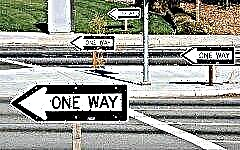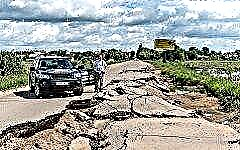

The content of the article:
- The countries of the Old World with the worst roads
Analysts of the Global Competitiveness Index annually make a rating of the quality of roads in the countries of the world. According to the ratings, Europe is beginning to pay less attention to road infrastructure.
About which countries got into the anti-rating of the quality of roads - in our review.
The countries of the Old World with the worst roads
1. Moldova

In the photo: billions of Moldovan lei disappear in bottomless pits
"Honored" leader in the abundance of pits and potholes for each meter of the road - Moldova. Here, motorists can fully "enjoy" the broken suspension, flying brakes and even fallen off wheels.
Technological violations during the laying of the roadway, leading to poor-quality repairs, lack of control and a unified infrastructure development plan - all this, combined with a rather specific climate, turns Moldovan highways into the worst in Europe.
Moreover, such roads can be seen not only outside big cities - neither the capital, nor Tiraspol, nor Bender can boast of convenient transport links.
Despite the fact that the Ministry of Transport and Road Infrastructure reports on the annual repair of more than 7 thousand roads, including half of national importance, the second half is local, this does not affect the quality of road infrastructure. Drivers continue to complain about the complete incompatibility of the roads available in the country to wheeled transport.
Local residents are outraged that the billions allocated for repairs are spent too uncontrollably: on unskilled construction crews, on useless patching, corruption, on bad materials, and are simply stolen.
With an ever-increasing road tax, motorists have to spend more and more money on repairing their cars.
In addition, experts from the American Gallup Analytical Institute noted the extremely low safety on Moldovan roads, including inadequate lighting and barriers.
2. Romania

In the photo: 70% of Romanian tracks are in bad or very bad condition.
Romania has the least developed transport artery, the situation in which is not much better than in Moldova.
High-speed highways in the country account for only 5% of the total road infrastructure, which is only 750 kilometers. With all the official statements by the authorities about the grandiose reconstruction of roads, in fact, only 22 new kilometers a year are being built.
In part, this slow process is due to bureaucratic obstacles in the issuance of construction and environmental permits. Then a lot depends on the tender for the work, when poor bidding documents lead to an illiterate project or to legal challenges.
In addition, ineffective development of road infrastructure, uncontrolled construction and repairs are causing real disasters. A striking example is 2015, when a part of a new road in the western part of the country collapsed due to landslides.
Finally, it is not uncommon for the cars of the tourist sector or freight carriers to overcome the extra tens or hundreds of kilometers on a straight road just because only this section of the track is able to withstand the standard European weight of 40 tons. As a result, drivers make a colossal detour simply because they have no choice or alternative route.
Romania is part of the pan-European transport corridor running from the sea terminal in Constantinia to Thessaloniki, as well as to the German Dresden and Nuremberg. This makes it all the more important to get the road infrastructure to function at full capacity.
3. Ukraine

In the photo: knee-deep pits - Ukrainian reality
Ukraine, which has classic giant potholes, lack of asphalt in the off-season, and poor repairs, has not escaped typical road problems.
Drivers tend to blame corruption for the sad environment, deliberate replacement of good materials with cheap ones, violation of technological processes during construction and repair work, for which, among other things, outdated equipment is used.
Another "chronic" misfortune is considered to be overloading of heavy trucks, which are inexorably destroying domestic routes. Nikolaev especially suffers, daily passing through itself hundreds of thousands of tons of various cargoes, which in the summer period at 30-degree heat simply kill the road surface.
The construction of each kilometer of the route costs the Ukrainian budget about a million dollars, which will pay off only after 10-12 years of active cargo transportation.
However, it is rare for an entrepreneur to correctly calculate the load and weight of his vehicle, which are legally permissible for the road surface, trying only to benefit from his business.
Since fuel and transport repairs are steadily becoming more expensive, they try to send the maximum amount of products for payback on each trip, thereby reducing the service life of their own roads.
4.Russia

In the photo: bad Russian roads have passed into the category of "national treasure"
Russia has long been sadly famous for its roads, which can already be ranked as a kind of local flavor.
The quality of the roads varies greatly depending on the region and region. For example, in the capital and in cities with a population of over one million, the roadbed is better, the layout of interchanges is more thought out and the infrastructure is monitored and controlled, while in Murmansk, Transbaikalia, the Far East, it is impossible to drive even on federal highways in good or bad weather.
Five reasons can be called disastrous for Russian roads:
- climate,
- studded tires,
- violation of technological processes when laying the coating,
- a large number of vehicles,
- corruption component.
The weather in our country really presupposes a careful choice of materials, technologies, proper care of the entire road infrastructure, which is exposed to all types of precipitation and sudden temperature changes.
Moreover, the technologies and materials used in the northern regions will fundamentally differ from the features of laying the canvas in hot cities, while construction contractors tend to carry out work according to uniform templates, the most costly in every sense.
A less obvious road problem is the spikes on the wheels, which do damage the top layer of the pavement, causing it to erode. It is not for nothing that they are universally banned for use in many other European countries.
As for the process of laying asphalt, every Russian has at least once observed how these activities are carried out in the rain or on freshly fallen snow, initially nullifying all efforts.
Finally, the abundance of affordable cars seriously overloads the roads, causing not only hours of congestion, but also damage to the roadway. The construction of new interchanges, the laying of new highways only aggravates the situation, only increasing the number of vehicles.
5. Latvia

In the photo: underfunding and overloading of trucks are to blame for bad roads in Latvia
Latvians joke that the border of their state with the Estonian one can be "felt" - the roads immediately become strikingly worse.
The authorities agree that the neighbors not only have less traffic, but also the building material is of much higher quality.
When the borders opened, the country joined the European Union, and transport poured into Latvia, it became clear that the highways were not ready for such loads. Especially for transit freight trucks, which now have a larger allowable limit compared to Soviet times, when Latvian roads were built.
Lithuanian roads have an increased resource, Estonian ones are kept in perfect condition, but in Latvia for so many years for some reason they have not learned how to competently develop road infrastructure.
At first there was no proper technology, specialized equipment, now there is not enough funding. For a truly complete restoration and subsequent maintenance of the Latvian road network, 2-3% of GDP will be required. Unfortunately, such funds never appear in the state treasury.
The Latvian authorities do not seem to understand the economic and strategic importance of the road network. Often, in order to save budgetary funds, one layer of pavement is laid instead of the required two, or a poor-quality foundation is used, due to which even a new road is quickly destroyed.
Drivers, in turn, see that funds are being allocated, work is being carried out, but the roads are still covered with holes, which causes a wave of negativity and complaints.
Conclusion
As the rating shows, the greatest problems with road infrastructure are observed in the countries of the former Soviet Union. The builders of communism sought to entangle the entire country with a transport system, with an emphasis on quantity, but not on quality.
And, of course, the problem of financing remains unchanged, when budgetary means can create the appearance of improving roads, thereby satisfying the drivers. However, these temporary solutions will only hide the shortcomings, but will not improve the situation with the restoration and maintenance of road infrastructure.











